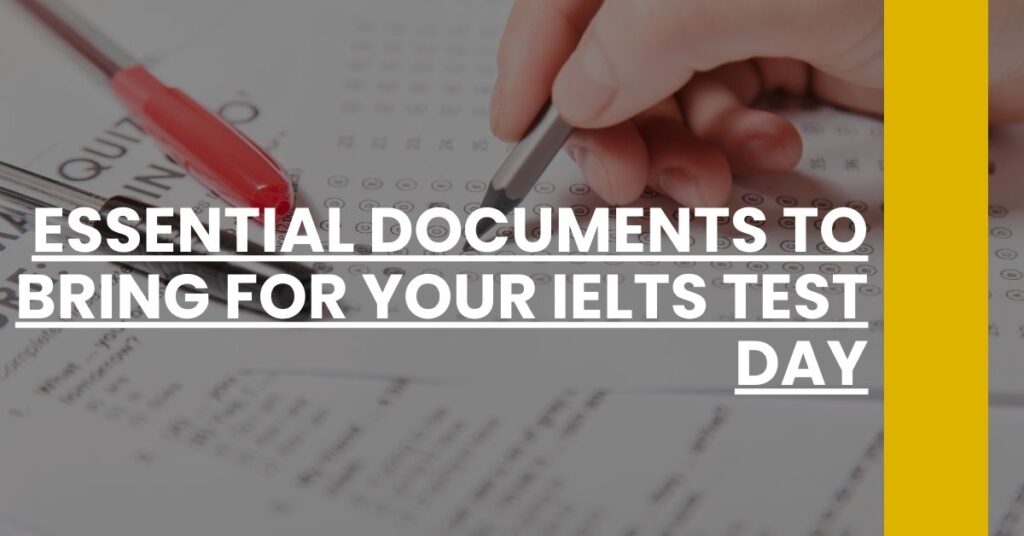Ever wondered exactly what documents do I need for IELTS exam to stroll in without a hitch on test day? You’re not alone in seeking clarity.
Avoid unnecessary stress by knowing precisely what to bring to the IELTS — from accepted ID forms to essential stationery. No guesswork, just straight facts for a smooth testing experience.
Here, we map out the must-haves that will have you prepped and confident when you step through those test center doors.
- 1. Valid Identification for Test Registration
- 2. Confirmation of Your Test Booking
- 3. Passport or National ID Card on Test Day
- 4. Recent Passport-Sized Photographs
- 5. Details of Your Test Center and Venue
- 6. Required Stationery Items
- 7. Confirmation of Special Arrangements (If Applicable)
- 8. Proof of Payment or Test Fee Receipt
- Information and Advice About Your IELTS Test Day
- What Is Not Allowed on IELTS Test Day?
- Conclusion: Final Checklist and Encouragement
1. Valid Identification for Test Registration
When you’re gearing up to take the IELTS exam, ensuring you have the correct documents can save you a world of stress. Top of that list is making sure you have a valid form of identification available at the time of registration, which you’ll also need to bring with you on the test day. Here’s what you should keep in mind:
- Passport: This is universally accepted. If you’re wondering exactly what documents do I need for the IELTS exam, this is your go-to.
- National Identity Card: In some regions, this may be accepted by IELTS. Both the passport and national ID must be valid not just at registration but also on the date of the exam.
Ensure the details on your ID, like your full name and date of birth, match the information you provide during registration. A little tip: upload a clear copy of your ID document while registering online, as specified on IELTS’s official website, to smoothen the process.
2. Confirmation of Your Test Booking
Once you’ve registered for your IELTS exam, you should receive a confirmation letter or email. This isn’t just another email to glance over and forget; it’s an essential document to carry on the test day:
- Reference: It’s your solid proof of venue, date, and time.
- Verification Tool: The details contained can help confirm your identity.
Safeguard this document as if it’s a key to unlock the test center doors. No need to panic, though—if you misplace it, get in touch with your test center promptly to obtain a replacement.
3. Passport or National ID Card on Test Day
You’ve already registered your details, now it’s test day. Don’t forget to bring along the same original identification document you used during the registration process:
- Consistency: Your test administrator will check to ensure the details match up with those provided during registration.
- Photographs: Some test centers may require additional photographs, but ensure these match the ID photos.
You might wonder, “Why emphasize this?” Well, mismatching documentation is a common pitfall leading to unnecessary test-day drama—and who needs that?
4. Recent Passport-Sized Photographs
Crystal-clear passport-sized photographs may be on the list of what documents do I need for the IELTS exam. Adherence to specific guidelines is crucial:
- Color: Go for full color with a plain background.
- Size: Typically, these should be standardized passport-sized shots.
Keep these handy because some test centers may ask for physical photographs along with your digital submission. For instance, this detailed blog shares insights into the subtleties of IELTS’s photo specifications.
5. Details of Your Test Center and Venue
Location, location, location—not just a real estate mantra but also crucial for your IELTS test day. Don’t waste precious time on Google Maps outside the test center; understand your venue ahead of time:
- Test Center Confirmation: Double-check the exact address of your test location.
Not knowing where to go can lead to unnecessary stress and possibly even tardiness. Before test day rolls around, do a trial run to the site—if you’re using public transportation, check the schedules to ensure you’ll arrive on time.
6. Required Stationery Items
Yes, even the humble pencil has its moment of glory on IELTS exam day. Unlike some tests where materials are provided, here’s what you should bring along:
- Pencils: Bring a couple, just in case one breaks.
- Eraser: For those little mistakes that you’ll correct and move on from triumphantly.
- Sharpener: Nothing’s worse than a blunt pencil when you’re trying to shade a perfect oval on your answer sheet.
Now, before you start packing a suitcase of stationery, note that for computer-based tests, you’ll be provided with what you need, but having your own familiar tools can be quite reassuring.
7. Confirmation of Special Arrangements (If Applicable)
If you have a disability or condition that requires special arrangements, IELTS accommodates these needs with open arms. Yours is a path just as important as any other’s. In fact, this element of inclusion is a shining testament to the humane values embedded within the test protocols.
Make sure you have the necessary documentation to confirm any special arrangements:
- Medical Certificates: Keep a signed statement from a medical professional handy.
- Details of the Condition: Provide a clear outline of how your condition impacts your test-taking ability.
The test center needs this information well in advance—typically six weeks prior to the test date—to make the appropriate accommodations, be it extra time or specialized equipment. IELTS’s commitment to accessibility means they take your needs seriously, as outlined on IELTS’s official guidance.
8. Proof of Payment or Test Fee Receipt
When you square away the financial aspect of the IELTS exam, keeping a proof of payment or your test fee receipt in your records is like having a financial safety net. It’s your tangible peace of mind and a safeguard against any hiccups surrounding your registration status.
- Proof: In case of discrepancies, your receipt is solid evidence of your test booking.
- Satisfaction: Knowing you’ve conclusively settled the fee lifts a weight off your shoulders.
No need to wave it around, but tucked in your wallet or folder, it’s a quiet reassurance that yes, you’ve crossed all the t’s in preparing for the IELTS.
Information and Advice About Your IELTS Test Day
Navigating the IELTS test day can be akin to mastering a new dance—there are steps to follow. Let’s walk through the rhythm of the day so you’re primed and ready:
- Registration: It’s check-in time, so arrive early.
- Security Processes: You’ll go through a routine check—just like at the airport.
- Test Instructions: Listen carefully here; the invigilator will walk you through the drill.
Between adjusting to the timed sections and managing test day jitters, you may forget these details. Don’t fret; the IDP IELTS test day guide has your back.
What Is Not Allowed on IELTS Test Day?
Your mental suitcase may be packed with preparation, but let’s make sure your physical one isn’t filled with prohibited items. Travel light to ensure nothing hampers your focus:
- No Electronics: Phones, smart watches, and other digital distractions are a no-go.
- Personal Belongings: Less is more here; too much clutter at your seat can be unsettling.
Following these guidelines protects the integrity of the test—and your score! The IELTS Test Day Rules are your go-to resource for the full embargo list.
Conclusion: Final Checklist and Encouragement
Before we part ways, let’s recap the essentials you’ll need to have down pat. This is your compass, your final checklist:
- Identification: The keystone to unlock your test—don’t forget it.
- Confirmation: The blueprint of your test details, guard it well.
- Stationery: Your toolkit for success—keep it sharp and ready.
Armed with your documents and a heart full of determination, you’re poised for greatness. Go forth, and conquer the IELTS with the confidence of one thoroughly prepared. You’ve got this!
What documents do I need for IELTS exam? Ensure a valid ID, confirmation, photos, stationery, and special arrangement proof.

